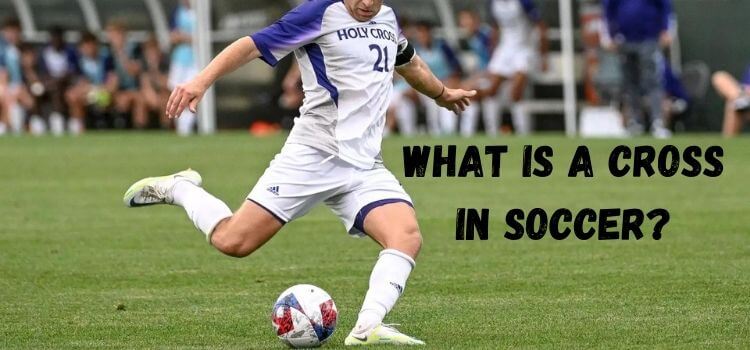As an Amazon Associate, I earn from qualifying purchases
What exactly is a cross in soccer? If you’ve ever watched a soccer match, you’ve likely seen players sending the ball into the penalty area from the wings, hoping a teammate can get on the end of it to score. That’s a cross! Crosses are pivotal in creating scoring opportunities, making them an essential skill in the game.

Types of Crosses
In-Swinging Cross
An in-swinging cross curves towards the goal in soccer, making it tricky for defenders and goalkeepers. It’s usually delivered with the player’s dominant foot from the opposite side of the field.
Out-Swinging Cross
Conversely, an out-swinging cross curves away from the goal. This type allows attackers to run onto the ball and head or volley it towards the goal with more momentum.
Low Cross
A low cross is sent close to the ground, ideal for quick, decisive finishes. These are particularly effective against high defensive lines.
High Cross
A high cross is lofted into the air to exploit tall attackers’ height advantage. It’s a staple when the team has solid aerial players.
Ground Cross
A ground cross is rolled along the ground. It is often used in fast-paced attacks where precision and speed are crucial.
Techniques for Executing Crosses
Foot Positioning
Proper foot positioning is crucial for delivering accurate crosses. Striking the ball with the inside of the foot helps control direction and curve.
Body Positioning
Your body should be slightly tilted and balanced to generate power and accuracy. In soccer, the angle of approach also influences the type of cross you deliver.
Timing and Accuracy
Crosses need impeccable timing. The passer and the receiver must be in sync, making communication vital. Accurate crosses are about precision, ensuring the ball lands in the optimal area for attackers.
Players Specializing in Crosses
Wingers
Wingers are often a team’s primary crossers. Their job is to send precise crosses into the box and outmuscle defenders on the wings.
Fullbacks
Modern fullbacks are also adept at crossing. They often overlap with wingers to provide additional crossing options.
Midfielders
Particular midfielders excel in delivering crosses from deeper positions, catching the defense off guard with unexpected deliveries.
Tactical Importance of Crosses
Creating Scoring Opportunities
Crosses are crucial in breaking down tight defenses. They offer a direct route to goal-scoring opportunities, bypassing packed midfield areas.
Stretching the Defense
By spreading the play to the wings, crosses force the defense to stretch, creating gaps for attackers to exploit.
Counter-Attack Strategy
Quick crosses can catch the opposition off balance in counter-attacks, leading to high-quality chances.
Training Drills for Improving Crosses
Repetition Drills
Players can improve their consistency and technique by constantly practicing crosses.
Crossing and Finishing Drills
Combining crossing drills with finishing drills helps simulate match conditions, improving the overall effectiveness of the team’s offensive play.
1v1 Wing Play Drills
These drills focus on beating defenders one-on-one before delivering a cross, honing dribbling and crossing skills.
Famous Crossers in Soccer History
David Beckham
Known for his pinpoint accuracy and bending crosses, Beckham is one of the most iconic crossers in soccer history.
Cristiano Ronaldo
Although more known for his goal-scoring, Ronaldo delivers robust, precise crosses from vast areas.
Trent Alexander-Arnold
A modern master, Alexander-Arnold’s crossing ability has been crucial in Liverpool’s attacking play.
Crosses in Different Soccer Formations
4-4-2 Formation
In a 4-4-2 formation, wingers and fullbacks frequently deliver crosses to the two central strikers.
4-3-3 Formation
A 4-3-3 formation relies heavily on the wide forwards and fullbacks to provide crosses to the lone striker and attacking midfielders.
3-5-2 Formation
Wing-backs in a 3-5-2 formation are primarily responsible for delivering crosses, supported by midfielders who drift wide.
Common Mistakes to Avoid
Overhitting the Ball
Putting too much power behind a cross often results in the ball flying over everyone’s head.
Miscommunication with Teammates
Lack of communication can lead to unmet or misdirected crosses, wasting opportunities.
Poor Timing
Crossing too early or late can ruin a scoring chance, making delivery timing crucial.
Crossing in Modern Soccer
Evolution of Crossing Techniques
Crossing techniques have evolved with the game, becoming more precise and varied to outsmart defenders.
Technological Aids in Training
Modern training uses video analysis and simulation tools to refine crossing techniques and improve decision-making.
Role of Crosses in Women’s Soccer
Impact on the Game
Crosses are just as vital in women’s soccer, contributing significantly to goal-scoring opportunities.
Notable Women Crossers
Players like Megan Rapinoe and Lucy Bronze are renowned for their exceptional crossing abilities.
Defending Against Crosses
Positioning of Defenders
Defenders must position themselves to intercept crosses while staying aware of attackers’ movements.
Goalkeeper’s Role
Goalkeepers are essential when it comes to handling crosses. They must frequently move off their line to punch or collect the ball.
Communication and Coordination
Effective communication between defenders and the goalkeeper is essential in dealing with crosses effectively.
Analyzing Successful Crosses
Case Studies
Analyzing successful crosses from past matches helps us understand what works and what doesn’t.
Statistics and Data
Data on crossing accuracy, success rates, and impact on goals provides valuable insights for improvement.
Fan Perspectives on Crosses
Excitement and Anticipation
Crosses often lead to some of the most exciting moments in a match, keeping fans on the edge of their seats.
Iconic Moments Created by Crosses
Many legendary moments in soccer history have come from perfectly executed crosses, creating lasting memories for fans.
Conclusion
Crosses are a fundamental aspect of soccer, contributing to its dynamism and unpredictability. Mastering this skill can significantly enhance a team’s offensive capabilities, from executing different types of crosses to understanding their tactical importance. As soccer evolves, the role of crosses continues to adapt, making them an evergreen element of the beautiful game.
FAQs
The best type of cross depends on the situation. In-swinging crosses create chaos in the box, while low crosses are effective against high defensive lines.
Practice consistently, focus on your foot and body positioning, and work on timing and communication with teammates.
Trent Alexander-Arnold, Kevin De Bruyne, and Kieran Trippier are some of the best crossers in modern soccer.
Crosses open scoring opportunities, stretch the defense, and are integral to counter-attack strategies.
Overhitting the ball is a common mistake, leading to missed opportunities. Ensuring the right balance of power and precision is critical.
Read Our More Articles
- Does Playing Soccer Make You Shorter? An In-Depth Look
- What Happens When a Soccer Coach Gets a Red Card?
- Does Soccer Have Cheerleaders? The Answer May Surprise You!
As an Amazon Associate, I earn from qualifying purchases


